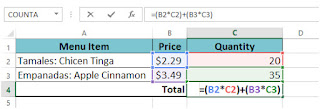Complex Formulae in Excel
Complex Formulae in
Excel
A complex formula has more than one
mathematical operator, such as 6+7*9. When there is more than one
operator in a formula, the order of operations tells Excel
which operation to calculate first.
The Precedence order
of operators
Excel calculates formulas based on the following order
of operations:
1.
Operations enclosed in parentheses
2.
Exponential calculations
(3^2, for example)
3.
Multiplication and division,
whichever comes first
4.
Addition and subtraction,
whichever comes first
A mnemonic that can help you remember the order is PEMDAS,
or Please Excuse My Dear Adorable
Student.
Solution
to this expression is as follows:
How to Create a complex formula
Let us show how Excel solves a complex formula using the order of operations. Here, we want to calculate the cost of sales tax for a catering invoice. To do this, we'll write our formula as =(D2+D3)*0.075 in cell D4. This formula will add the prices of our items together and then multiply that value by the 7.5% tax rate (which is written as 0.075) to calculate the cost of sales tax.
Excel follows the order of operations and first adds the values inside the parentheses: (44.85+39.90) = $84.75. It then multiplies that value by the tax rate: $84.75*0.075. The result will show that the sales tax is $6.36.
It is especially important to enter complex formulas with
the correct order of operations. Otherwise, Excel will not calculate the
results accurately. In our example, if the parentheses are not
included, the multiplication is calculated first and the result is incorrect.
Parentheses are the best way to define which calculations will be performed
first in Excel.
To create a complex formula using the order of
operations:
In our example below, we will use cell
references along with numerical values to create a
complex formula that will calculate the total cost for a
catering invoice. The formula will calculate the cost for each menu item and
then add those values together.
1.
Select the cell that will
contain the formula. In our example, we'll select cell C4.
2.
Enter your formula. In our
example, we'll type =B2*C2+B3*C3. This formula will follow the
order of operations, first performing the multiplication: 2.29*20 =
45.80 and 3.49*35 = 122.15. It then will add those values
together to calculate the total: 45.80+122.15.
3.
Double-check your formula for accuracy,
then press Enter on your keyboard. The formula will calculate and
display the result. In our example, the result shows that the total
cost for the order is $167.95.
You can add parentheses to any equation
to make it easier to read. While it won't change the result of the formula in
this example, we could enclose the multiplication operations within parentheses
to clarify that they will be calculated before the addition.
Excel will not always tell you if
your formula contains an error, so it's up to you to check all of your
formulas.





Comments
Post a Comment